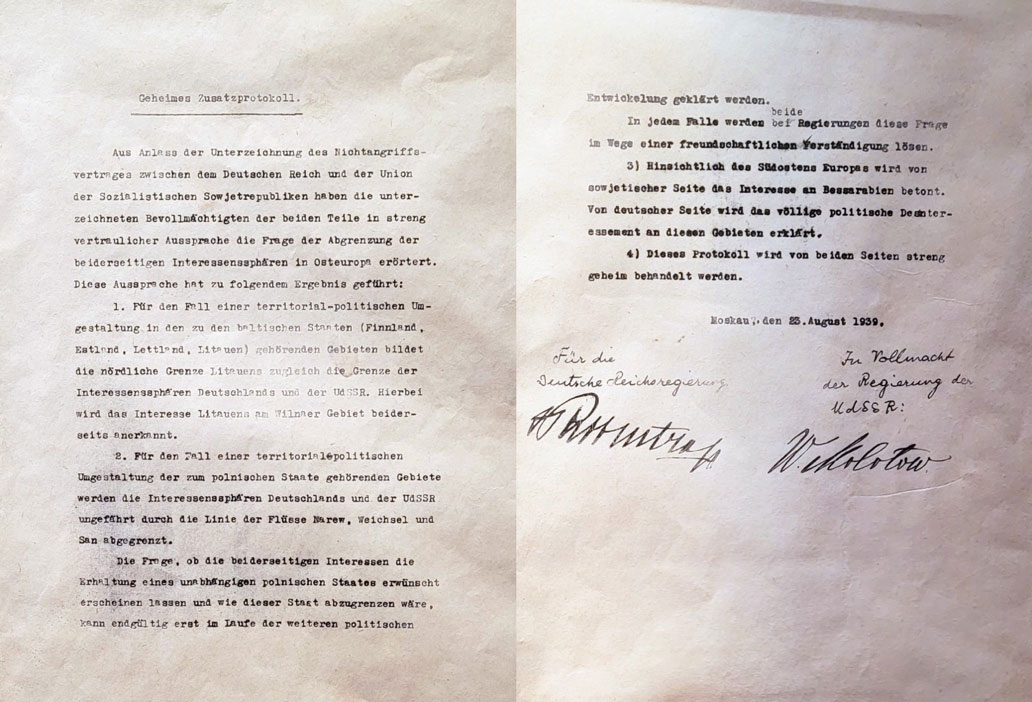Nazi-Soviet pact sealed the fate of several countries

Eighty-four years ago this week, Nazi Germany and the Soviet Union signed the Molotov-Ribbentrop Pact. In recognition of this moment in history—marked in Europe as Black Ribbon Day—I offer a short excerpt from my forthcoming book on socialism in Estonia with Peter Boettke and Konstantin Zhukov.
On Aug. 23, 1939, Joachim von Ribbentrop, the German foreign minister, landed in Moscow. Stepping off the plane, he was greeted by six enormous swastika flags. The Russians had obtained them from a Soviet propaganda film studio where they had recently been employed as props in films denouncing the Nazis. Now the flags were proudly displayed, though carefully concealed from the street so that common Russians would not see them. Ribbentrop was rushed to the Kremlin where he met with Stalin and, around midnight, finalized the details of the Molotov-Ribbentrop non-aggression pact. Ribbentrop’s Soviet counterpart, Vyacheslav Molotov, had only recently been appointed commissar of foreign affairs by Stalin. He replaced the Jewish Maxim Litvinov, who had been dismissed by Stalin as a conciliatory gesture to Hitler. Once the pact was signed (see photo of the original document at the bottom of the page), Stalin toasted to Hitler’s health.
Though both Hitler and Stalin characterized one another as ideological opposites, the dictators had more in common than totalitarian terror. For his part, Hitler’s National Socialist party platform contained a half dozen planks that lived up to the socialist part of its name. These included “breaking the slavery of interest” (plank 11), “nationalization of all businesses which have been formed into corporations” (plank 13), “communalizing of big department stores” (plank 16), “expropriation of land for communal purposes without compensation,” the “abolition of ground rent,” and the “prohibition of all speculation in land” (plank 17).
And though Hitler may not have known it at the time, Stalin had already shown a Hitlerian capacity for mass murder. Over the preceding three years Stalin had killed 247,157 Soviet citizens in the Great Terror. The historian Timothy Snyder describes it this way:
As of the end of 1938, the USSR had killed about a thousand times more people on ethnic grounds than had Nazi Germany. The Soviets had, for that matter, killed far more Jews to that point than had the Nazis. The Jews were targeted in no national action, but they still died in the thousands in the Great Terror—and for that matter during the famine in Soviet Ukraine. They died not because they were Jews, but simply because they were citizens of the most murderous regime of the day.
There was also a practical element to the alignment. Stalin felt he had more to gain from aligning with Germany than with Great Britain and France. And as Stalin later put it, he and Hitler had a “common desire to get rid of the old equilibrium.”
In any case, the pact publicly committed Nazi Germany and the USSR to non-aggression. But it was the secret protocols of the pact—denied by the Soviet Union for 50 years—which reshaped the world and threw Estonia into a half-decade of crisis. The new allies agreed to carve up Europe, splitting Poland down the middle and granting Finland, Estonia, Latvia, Romania and (later) Lithuania to the Soviets. They wasted no time. On September 1, Germany invaded Poland from the west and on September 17 the USSR invaded from the east. Less than a week later, the Nazis and Soviets were both in the Polish city of Brest-Litovsk holding a joint parade. By the end of the month, the invaders were in control of Poland. Next, the Soviets turned to Estonia.
We tell the full story of Poland’s invasion and occupation in The Road to Socialism and Back: An Economic History of Poland, 1939-2019. And we’ll tell Estonia’s part of the story in our upcoming book.


